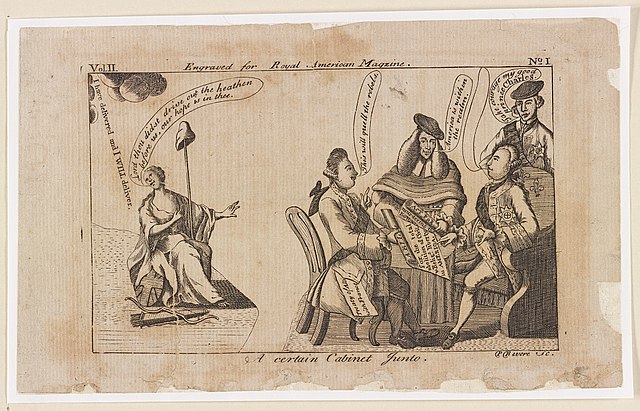The Sources for Revere’s Window Art
My second thought on the art that followed the fatal events of early 1770 is perforce not as developed as yesterday’s.
Of the three images that Paul Revere illuminated in his windows on the first anniversary of the Boston Massacre in 1771, we can connect two of them to other images he produced.
One window showed:
In another window was:
Revere clearly copied that figure of America, and most of the “America in Distress” composition, from “Britannia in Distress,” a print that appeared in the Oxford Magazine in 1770. (The rest of his “Cabinet Junto” came from “A retrospective View of a certain Cabinet Junto” published in 1773.) Thus, Revere probably had access to his source for “a Woman, representing AMERICA,” by early 1771.
That leaves this image:
Revere hardly made any engravings without copying from someone else’s engraving or drawing. And when he tried, the results were poor. Though Revere was skilled at engraving decorations on metal, drawing human faces, figures, and landscapes in perspective was not among his talents.
Therefore, I suspect there must be some model or models for Revere’s Seider picture—a picture of a youth with a finger in a bleeding wound and perhaps a separate picture of a memorial obelisk and bust. One or the other of those images would include some weeping mourners.
I’ve kept my eye open for possible models in looking at Revere’s other work and at British engravings. Occasionally I’ve run keyword searches on the British Museum website, source of the original prints I’ve linked to above. But so far I’ve come up empty.
Of the three images that Paul Revere illuminated in his windows on the first anniversary of the Boston Massacre in 1771, we can connect two of them to other images he produced.
One window showed:
the Soldiers drawn up, firing at the People assembled before them—the Dead on the Ground—and the Wounded falling, with the Blood running in Streams from their Wounds: Over which was wrote FOUL PLAY.The caption was new, but otherwise that description matches the picture that Revere copied from Henry Pelham to make a famous engraving and later carved as a woodcut as well.
In another window was:
the Figure of a Woman, representing AMERICA, sitting on the Stump of a Tree, with a Staff in her Hand, and the Cap of Liberty on the Top thereof,—one Foot on the Head of a Grenadier lying prostrate grasping a Serpent.—Her Finger pointing to the Tragedy.Revere engraved America, grenadier, and serpent beside his picture of John Hancock for the Royal American Magazine in March 1774. That America was standing, but Revere included a similar America, sitting this time, in his illustration “A certain Cabinet Junto” in January 1775, as shown above. The same female figure appeared in mirror image in “America in Distress” two months later.
Revere clearly copied that figure of America, and most of the “America in Distress” composition, from “Britannia in Distress,” a print that appeared in the Oxford Magazine in 1770. (The rest of his “Cabinet Junto” came from “A retrospective View of a certain Cabinet Junto” published in 1773.) Thus, Revere probably had access to his source for “a Woman, representing AMERICA,” by early 1771.
That leaves this image:
the Ghost of the unfortunate young [Christopher] Seider, with one of his Fingers in the Wound, endeavouring to stop the Blood issuing therefrom: Near him his Friends weeping: And at a small distance a monumental Obelisk, with his Bust in FrontTo be frank, this picture seems a bit busy—an obelilsk and a bust and a bleeding ghost?
Revere hardly made any engravings without copying from someone else’s engraving or drawing. And when he tried, the results were poor. Though Revere was skilled at engraving decorations on metal, drawing human faces, figures, and landscapes in perspective was not among his talents.
Therefore, I suspect there must be some model or models for Revere’s Seider picture—a picture of a youth with a finger in a bleeding wound and perhaps a separate picture of a memorial obelisk and bust. One or the other of those images would include some weeping mourners.
I’ve kept my eye open for possible models in looking at Revere’s other work and at British engravings. Occasionally I’ve run keyword searches on the British Museum website, source of the original prints I’ve linked to above. But so far I’ve come up empty.


No comments:
Post a Comment